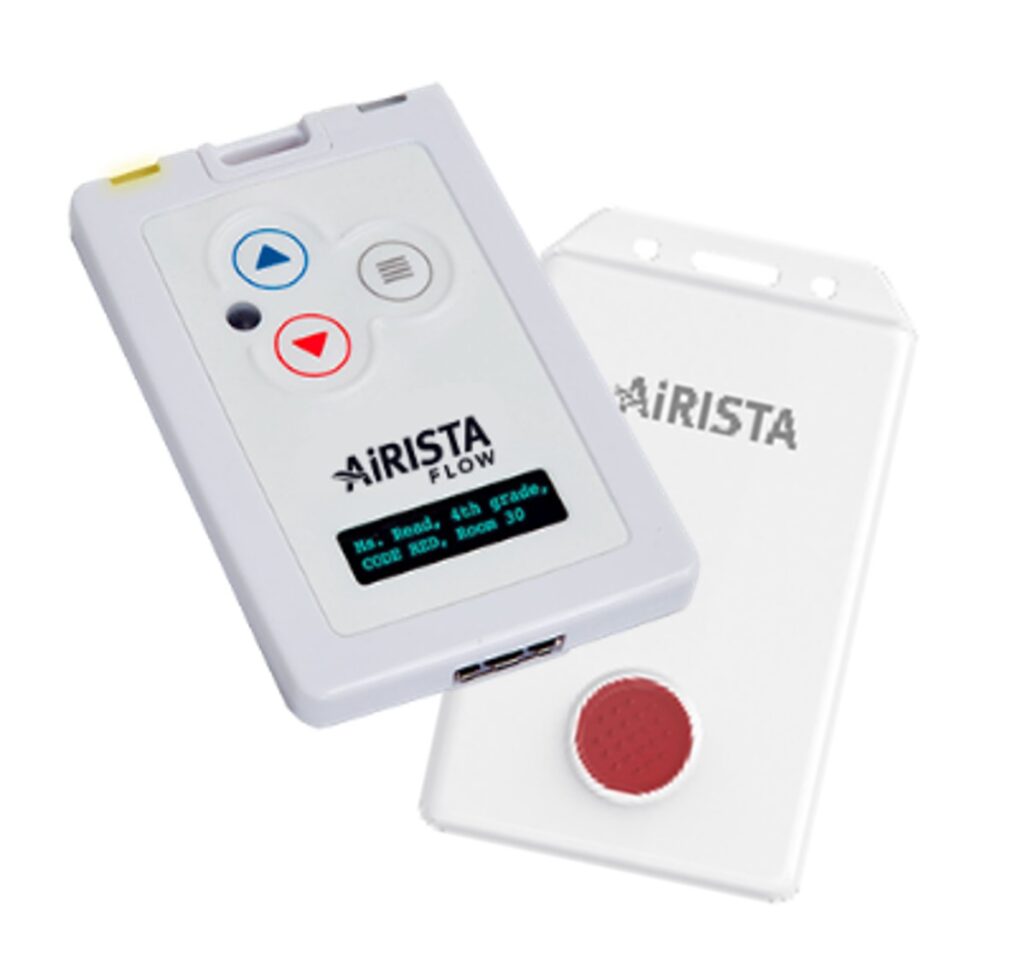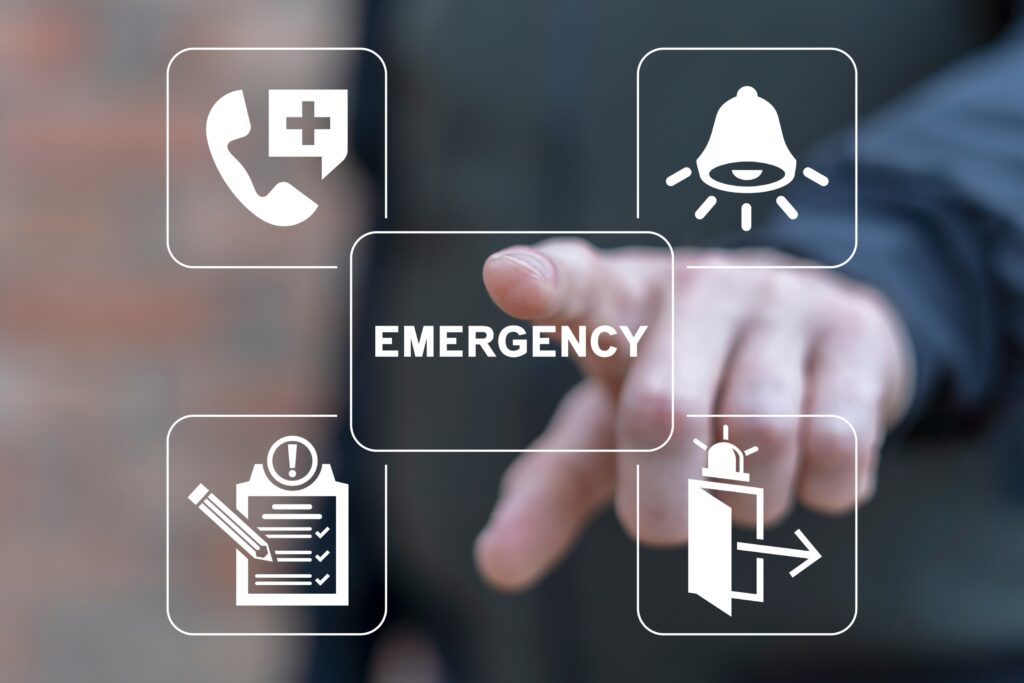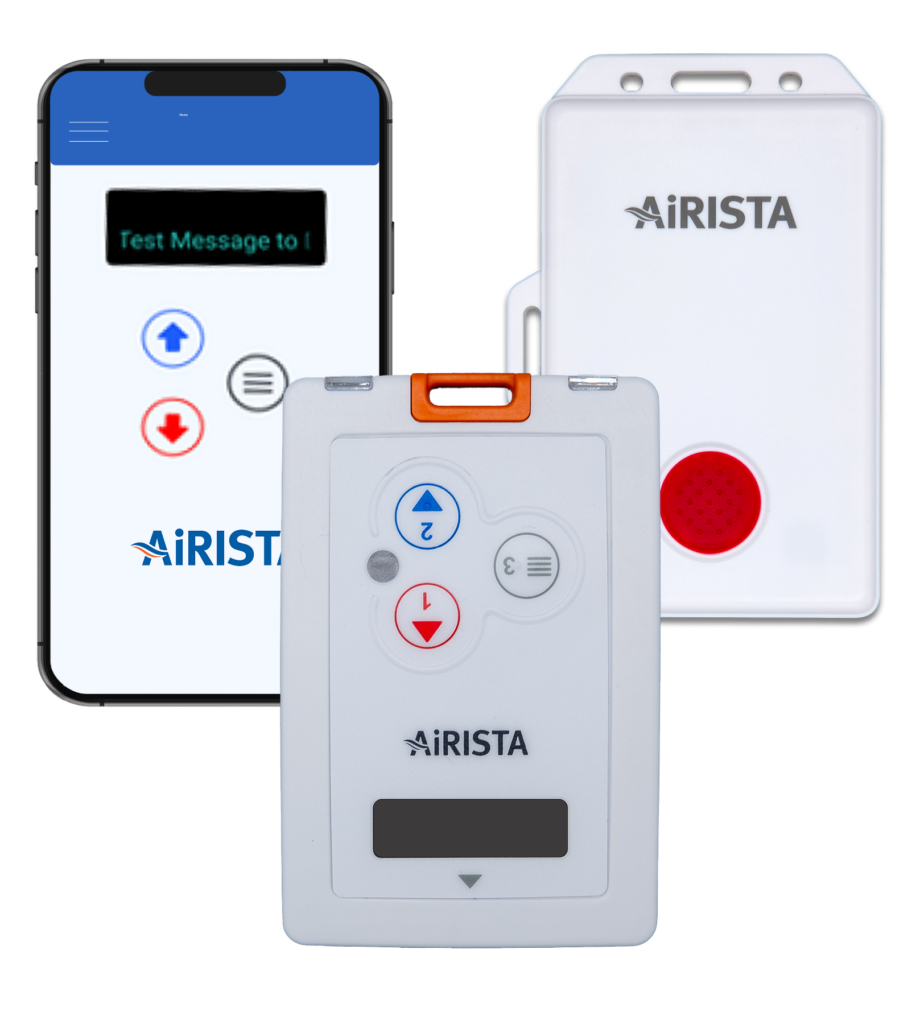A duress button is a discreet safety device designed to send an emergency alert when an individual is under threat. Unlike panic buttons, which trigger loud alarms, duress buttons operate silently, allowing for a covert request for assistance without escalating a dangerous situation. These devices play a critical role in personal and workplace safety, particularly in industries where employees may face risks such as violence, theft, or emergencies. Duress alarms, including various types like panic buttons, are essential in workplaces, schools, and other settings to ensure safety and well-being.
In high-risk environments like healthcare, hospitality, corporate offices, and educational institutions, duress buttons provide immediate communication with security personnel in an emergency or dangerous situation. AiRISTA enhances these systems with Real-Time Location Systems (RTLS), enabling precise location tracking to ensure responders can act swiftly and effectively. By integrating duress buttons and staff badges with pull tags into location-based intelligence, organizations can enhance response efficiency, ensuring that help arrives precisely where it is needed in a crisis situation.
Definition and Purpose
A duress button is a security device designed to alert emergency personnel or security teams in emergency or dangerous situations. Its primary purpose is to provide a quick and discreet way to summon help in situations where an individual’s safety is at risk. Duress buttons are often used in various industries, including healthcare, hospitality, retail, education, and government buildings, to protect employees and individuals from potential threats. These devices are crucial in environments where immediate assistance is necessary to prevent harm or escalate a response to a potential threat.
How a Duress Button Works

A duress alarm button can be integrated with access control systems and activated through various means, including physical buttons installed under desks, wireless wearables, or mobile applications. Some systems feature motion-sensitive activation, enabling an individual to trigger an alarm discreetly by shaking a wearable device or pressing a hidden button on a mobile app. Once pressed, an alert is sent directly to security teams or law enforcement, ensuring a quick response. Some systems also integrate with monitoring centers to escalate emergency responses when necessary.
Advanced duress button systems, such as those powered by AiRISTA’s RTLS technology, offer real-time tracking of personnel, providing crucial data that helps responders pinpoint an individual’s exact location. With AiRISTA’s two-way tag communication, staff can receive confirmation that their distress signal has been acknowledged, reducing uncertainty in high-stress situations. Alerts are delivered in as little as 1–2 seconds, enabling an almost instantaneous response. This rapid communication, combined with automated escalation procedures, ensures that if the initial response team is unavailable, alerts are seamlessly rerouted to backup security personnel or emergency responders—enhancing overall safety and minimizing delays in critical situations.
Types of Duress Buttons
There are several types of duress buttons available, each designed to meet specific needs and situations. Some common types of duress buttons include:
Wired Duress Buttons
Connected directly to a central monitoring system, wired duress buttons provide a secure and dependable method for alerting emergency personnel. Commonly found under desks or mounted on walls, they are ideal for fixed-location use.
Wireless Duress Buttons
With wireless connectivity, these buttons transmit alerts without the need for physical wiring, offering increased flexibility. Their portable design allows for placement in multiple areas or use by individuals in motion.
Silent Duress Buttons
Built to send a discreet alert, silent duress buttons enable users to call for help without drawing attention. This is especially beneficial in high-risk situations where remaining unnoticed is critical.
Audible Duress Buttons
Designed to emit a loud alarm, audible buttons notify everyone nearby of an urgent situation. They are best suited for environments where public awareness can help ensure a swift response.
Mobile Duress Buttons
Perfect for individuals on the move, mobile duress buttons provide quick access to emergency assistance wherever it’s needed. These may be built into mobile devices or carried independently for added safety.
Key Benefits of Duress Buttons

Duress buttons are essential tools for ensuring the safety of employees, students, and individuals in vulnerable situations. They provide an immediate and discreet distress signal that allows security teams to intervene quickly. With rapid emergency response capabilities, organizations can mitigate risks, prevent workplace violence, and create a safer working environment.
Duress alarm buttons have wide applications and life-saving benefits across various commercial and public settings. They are effective in emergencies such as armed robberies and medical crises, and their discreet design and integration with security systems enhance safety for businesses and schools.
Beyond safety, duress buttons act as deterrents to threats, signaling that organizations have robust security measures in place. Additionally, when combined with geofencing, duress button activations can trigger automated security protocols, such as locking doors, activating alarms, or redirecting video surveillance to the incident location.
Duress Button vs Panic Button
While often confused, duress buttons and panic buttons serve different purposes. A duress alarm is designed for silent, discreet emergency signaling to summon help during threats, making it ideal for situations where drawing attention could increase danger. Panic buttons, on the other hand, create an audible alert to notify people nearby of an emergency.
Choosing the right system depends on the specific security needs of an organization. AiRISTA offers customizable safety solutions that help businesses determine the best approach, whether they require silent distress signals or loud alerts to mobilize a broader response. Organizations should evaluate factors such as workplace environment, threat levels, and response protocols to determine whether a duress button, a panic button, or a combination of both is best suited to their security strategy.
Industries and Use Cases
Healthcare facilities utilize duress buttons to protect nurses, doctors, and staff from workplace violence. These buttons are often integrated with RTLS tracking to enable security teams to locate distressed employees quickly and efficiently. In addition, duress buttons are crucial during a medical emergency, ensuring rapid responses from security or first responders to provide immediate medical assistance. In hospitality, hotel staff can discreetly call for help in unsafe situations, meeting industry regulations requiring security measures for housekeeping and customer-facing personnel.
Corporate offices and educational institutions integrate duress button systems to enhance workplace and campus security, providing peace of mind to employees, students, and faculty. Retail stores and banking environments rely on them to prevent theft and ensure employee safety, particularly in businesses that handle high-value transactions. In retail stores, panic buttons are often installed near cash registers or in discreet locations to allow employees to alert authorities during threatening situations. AiRISTA’s location-based tracking solutions further strengthen these applications by providing real-time alerts and automated security responses, enabling security teams to assess and react to threats more effectively.
Emergency Response Plan

An emergency response plan is a critical component of any duress button system. This plan outlines the procedures to be followed in the event of an emergency, ensuring that emergency personnel or security teams respond quickly and effectively. A well-planned emergency response plan should include:
- Procedures for Alerting Emergency Personnel: Clearly defined procedures for activating the duress button and alerting emergency personnel or security teams. This ensures that everyone knows how to summon help quickly and efficiently.
- Protocols for Responding to Different Types of Emergencies: Established protocols for responding to various types of emergencies, such as medical emergencies, security breaches, or natural disasters. This helps ensure that the appropriate response is taken for each specific situation.
- Training for Employees: Regular training for employees on emergency procedures, including the use of duress buttons and emergency response protocols. Training ensures that employees are prepared and confident in their ability to respond to emergencies.
- Regular Drills and Exercises: Regular drills and exercises to test emergency response plans and ensure that emergency personnel or security teams are prepared to respond effectively. These drills help identify any weaknesses in the plan and provide opportunities for improvement.
- Review and Update of Emergency Response Plan: Regular review and update of the emergency response plan to ensure that it remains effective and relevant. This includes incorporating feedback from drills and real-life incidents to continuously improve the plan.
By implementing a comprehensive emergency response plan, organizations can ensure that they are prepared to respond to emergencies quickly and effectively, minimizing the risk to individuals and property.
Enhancing Safety with Duress Button Systems
Duress buttons, as essential security devices, provide a crucial layer of personal safety for individuals in high-risk environments. By enabling real-time tracking and seamless integration with security systems, they improve emergency response times and reduce the likelihood of workplace violence. Organizations that prioritize safety benefit from a proactive security approach, fostering a safer and more confident workforce.
For businesses seeking to enhance their security measures, selecting the right duress button system is a vital step in developing a comprehensive emergency response plan. Duress tracking solutions offer advanced safety tools that ensure compliance, improve response efficiency, and ultimately create a more secure working environment. With real-time tracking and seamless security integration, organizations can protect their most valuable assets—their people—more effectively than ever before.
Choosing the Right Duress Alarm System with AiRISTA

Selecting a duress button system with AiRISTA involves several key considerations, including security requirements, integration capabilities, and ease of use. AiRISTA works closely with organizations to understand their staff safety concerns and identify potential risks. Our RTLS solutions are tailored to address these challenges, providing real-time visibility and tools that support a safer, more responsive workplace. The importance of AiRISTA’s duress alarm systems in enhancing security cannot be overstated, especially in corporate environments where they protect against internal and external threats.
AiRISTA’s integration of duress buttons with access control systems further enhances security by ensuring that help can be summoned quickly and efficiently during critical situations. Customization and scalability are central to AiRISTA’s approach, as a one-size-fits-all solution may not be effective across different industries. AiRISTA offers modular duress solutions that adapt to unique business requirements, ensuring comprehensive protection. These systems can be scaled across multiple locations, providing centralized monitoring for large enterprises. The ability to integrate AiRISTA’s duress buttons with existing security infrastructure—such as surveillance systems, access control, and alarm systems—further enhances their effectiveness.
Proper training is also necessary to maximize system effectiveness. AiRISTA provides user-friendly software and real-time training analytics to ensure employees understand emergency procedures and can respond effectively under pressure. Employees should be educated on how and when to activate duress buttons, as well as what to expect once an alert has been sent.
Regulatory compliance is another key factor. AiRISTA’s compliance-ready solutions help businesses meet OSHA and other safety regulations, ensuring legal adherence while prioritizing employee protection. Ensuring compliance with industry-specific regulations is not only a legal necessity but also a crucial component of fostering a safe and secure work environment with AiRISTA.
Frequently Asked Questions (FAQ) about Duress Buttons
What does a duress button do?
A duress button serves as a silent alarm system designed to alert emergency personnel or security teams in the event of an emergency or dangerous situation. It provides a discreet way to summon help, ensuring a quick response without escalating the situation.
What is the difference between a panic button and a duress button?
While both are emergency alert devices, a duress button is typically silent, allowing for discreet help requests, whereas a panic button triggers an audible alarm to alert people nearby. The choice between the two depends on whether the situation requires discretion or immediate public awareness.
Where are duress buttons commonly installed?
Duress buttons are often installed in high-risk environments such as healthcare facilities, corporate offices, retail stores, and government buildings. They can be found under desks, on walls, or as wearable devices, providing flexibility for different security needs.
How do duress buttons integrate with access control systems?
Duress buttons can be integrated with access control systems to enhance security measures. When activated, they can trigger automated responses such as locking doors, alerting security teams, and redirecting video surveillance to ensure a swift and effective emergency response.





